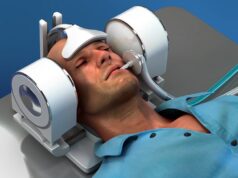
Philips has announced that, on 29 November 2023, the WE-TRUST study enrolled its 100th patient, marking what the company describes as an “important milestone” in the target of enrolling more than 500 stroke patients by the end of 2024. The 100th patient, a 70-plus-year-old female admitted less than three hours after symptom onset, was enrolled at the Hospital Geral de Fortaleza (Fortaleza, Brazil) by the clinical team of Francisco Mont’Alverne and Fabricio Oliveira Lima.
According to Philips, the WE-TRUST clinical study is a large-scale randomised controlled trial investigating a faster path to treatment for stroke. More specifically, this multicentre, prospective study is assessing whether a direct-to-angio-suite (DTAS) workflow improves outcomes for early time-window stroke patients compared to the conventional magnetic resonance (MR)/computed tomography (CT) scan before transfer to the angio-suite pathway.
“We believe the main benefit the WE-TRUST study will bring to patients and society is that, if we can treat patients on average 30 to 45 minutes faster, we are going to rescue more brain tissue and therefore improve outcomes,” said WE-TRUST principal investigator Raul Nogueira (University of Pittsburgh Medical Center [UPMC] Stroke Institute, Pittsburgh, USA). “When we designed the study, it was based on the premise that the CT or MR images for about 85% of stroke patients that present within the first six or eight hours after symptom onset indicate that the patients are suitable for thrombectomy treatment to remove the blood clot in their brain. So, in the conventional treatment pathway, we are doing CT or MR imaging to potentially exclude 15% of the patients who do not have a favourable imaging profile for thrombectomy. However, we suspected that even those patients could still benefit from treatment. As six large randomised clinical trials have now confirmed that this is the case, we have an even stronger reason to pursue this trial.”
“When you begin clinical studies, you typically struggle with recruitment at first and it seems like you are never going to get to the finish line,” added fellow WE-TRUST principal investigator Marc Ribo (Vall d’Hebron University Hospital, Barcelona, Spain). “However, once you get to a critical mass of participating centres with well-trained people, then recruiting usually flies. So, it appears that we have gone through the most difficult part of WE-TRUST and now we have a consistent number of participating centres that are screening and recruiting patients every week. As a result, recruitment for WE-TRUST is growing quickly and steadily, which we are very happy about. The sites that are active now are really promising, with nearly all of them heavily involved in recruitment.
“Implementing direct transfer to the angio suite will hopefully show that we are not only helping patients, but also reducing societal costs and economic costs for hospitals. We are not only reducing disability—we are reducing length of stay and reducing the cost to hospitals. These savings can then be used to implement new angio suites dedicated to stroke admissions because, if you want to consistently implement direct transfer to the angio suite every hour of the day, you need to think about having a dedicated space for these patients.”
“We needed to answer the question: which pathway is better for triaging the patient in our hospital—direct-to-angiography or conventional imaging? There are three main reasons why we are the top enroller in WE-TRUST,” stated Serdar Geyik and Arsida Bajrami (Aydin University Stroke Center, Istanbul, Turkey), whose centre has enrolled the highest number of WE-TRUST patients to date. “The first is that we are a high-volume stroke centre. We perform around 400 thrombectomies a year, which gives us the capability to enrol more patients. The second is the organisation of our centre, which involves a group of dedicated stroke physicians and dedicated stroke technicians, plus two angio suites. We do not have separate teams. There is no emergency room or separate neuro team in our scenario. There is just one dedicated stroke team. They take the patient and then decide to enrol or not to enrol, and that is it. It means we are ready to accept direct-to-angio patients most times of the day.
“The third reason is our firm commitment to enrol patients to see how beneficial this study will be, because we believe very much in WE-TRUST and the direct-to-angio approach. It promises to be a whole new revolution, because everyone right now is trying to shorten the triage time and do fast thrombectomy. If we can prove that the DTAS pathway achieves better outcomes for patients compared to the conventional pathway, it will be beneficial for the whole world.”











